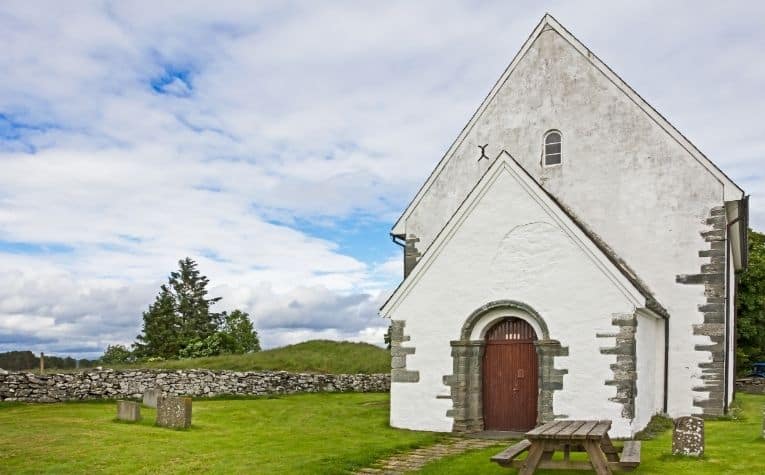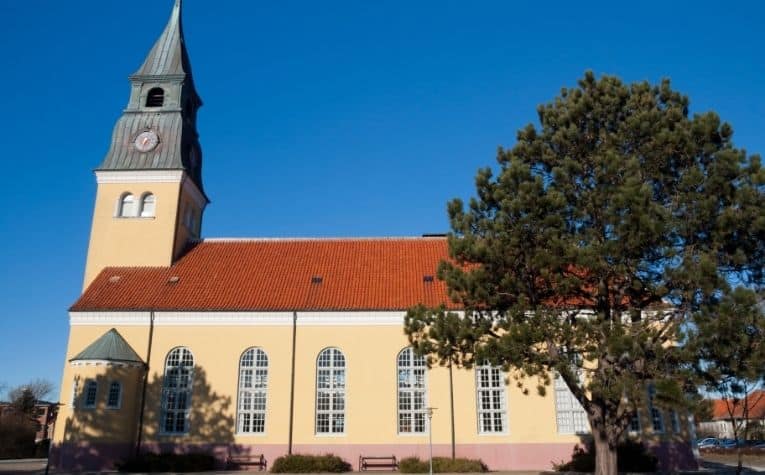Scandinavia’s conversion to Christianity occurred over time. Residents of Norway, Sweden, Denmark, Finland, and Iceland, turned away from the Norse belief system to the faith of Jesus Christ.
Scandinavia’s conversion to Christianity from Norse paganism started in the 10th century and was collectively completed by the 12th century.
Christian countries to the south, and the missionaries they sent north, were largely responsible for the religious transformation of Northern Europe.
The region’s conversion to Christianity was a significant reason for the decline of the Viking era. With new beliefs came a new way of life. Keep reading to learn more.
To compare Norse Mythology vs Christianity, see Norse Mythology vs Christianity to learn more. Includes multiple comparison charts.

Christian missionaries in Scandinavia
Scandinavia’s transformation to the Christian faith manifested differently in each country.
For example, Denmark’s conversion to Christianity looked different than Norway’s, Norway’s conversion looked different than Sweden’s, and so on.
Yet there were similarities between their conversion stories as well because people were turning from the same Norse belief system and to the same new faith, Christianity.
The most significant turning points in Scandinavia’s conversion to Christianity occurred between 950-1050 A.D.
Christianity penetrated northern Europe during this time, but the faith didn’t stabilize until centuries later.
- Denmark and Norway were the first nations to convert to Christianity in northern Europe. Denmark’s geographical proximity to other Christian countries in Europe accelerated its transformation. Though some Danes and Norwegians remained loyal to Norse paganism, these nations were collectively converted by 1100 A.D.
- Sweden eventually followed the lead of their Scandinavian neighbors. Some nations in the region that converted later than others were the last to receive missionaries. Sweden was collectively converted around 1200 A.D., solidifying a regional religious conversion.
Louis the Pious: Missionary activity started in Northern Europe when Louis the Pious (778-840), son of Charlemagne, sent missionaries into southern Scandinavia.
Most Europeans at the time considered northerners barbarians and believed the stereotype that the Vikings were uncivilized and brutish. (Also see Why Did the Vikings Leave Scandinavia?)
Pope Stephen IV: While some conversions to Christianity occurred as a result of the first missionaries, their evangelistic success was not widespread.
Some Christian leaders wanted to cease missionary activity in Scandinavia because it was expensive and unfruitful and send their evangelists elsewhere.
However, Pope Stephen IV (770-817) himself intervened in that plan. He decided that the church’s work in the north would be funded and continue. (Also see Was Ragnar Lodbrok a Christian?)
Other than Christianity, what other religions do Scandinavians follow? See Religion in Scandinavia to learn more.

Why did Norse Paganism Wane in Scandinavia?
While the success of Christian missionaries experienced ebbs and flows in Northern Europe, Scandinavians who were living in places like England, Ireland, and parts of Germany, began to convert to the faith of their religious surroundings while abroad.
While the Vikings physically attacked their neighbors by means of raiding, in a sense, Norse paganism was under a different kind of attack, from both inside and outside Scandinavia. (Also see Is Norse Paganism Still Practiced?)
Baptism and leadership: Viking converts to Christianity were often baptized, a ceremonial act taught by Jesus and recorded in the New Testament.
Christian baptism signifies, in part, that a person has undergone a conversion, has a new identity, and is part of a new community made of up faithful believers.
After baptism, churches common instructed new converts in the ways of the Christian faith as taught in the Bible, even though physical copies of the Old and New Testaments were uncommon relative to later eras.
Converts that showed skills in administration and genuineness sometimes rose to leadership positions in the church. (Also see Norse Paganism vs Christianity: Comparison)
Large-scale transformation: Individual conversions often became collective transformations.
- When a man converted to the Christian faith, so did his wife and children. Families shared belief systems, in part, so members would be in alignment on things like priorities, values, and behaviors.
- When a chieftain turned to it, so did his village. For villagers who willingly converted, they may have done so, in part, to be in the good graces of their leader. Other times they may have been forced to convert on threat of injury or death.
- When a king turned to it, so did his country. Like in a village, but on a larger scale, people may have followed the lead of their king to curry his favor or to avoid punishment.
In the latter half of the 10th century, like a breached dam, the Christian faith poured into Denmark, Norway, and Sweden. As a result, the Viking worldview — Norse paganism — was abandoned in droves.
When more Christian churches were established and grew in size, bishops were assigned to oversee them. Missionaries from England in particular helped plant and establish new churches in Scandinavia.
Ragnar Lodbrok is one of the most famous Vikings of all time, but there is a lot of misinformation about him. See Ragnar Lodbrok: Separating Fact from Fiction to learn more.

Were all Viking conversions authentic?
Were Scandinavian converts to Christianity sincere in their belief or did they change religious allegiances for other reasons? It is sometimes difficult to know for sure.
By nature, religious beliefs are internal convictions, though they have outward expressions, so it can be challenging to use external measurements to assess their genuineness.
Some historians have reason to believe that many Viking conversions were nominal — i.e. by name only — and not the result of changed religious convictions.
One historian argues that Scandinavian conversions were “probably largely politically motivated, at least on the part of the Viking leaders, in terms of both improving relations with Christian nations and bolstering and consolidating the Scandinavian kingdoms.” [1]
A Christian historian agrees:
“At the outset the vast majority of the nominal Christians were quite aware of the nature of the Gospel or of the kind of life entailed through the new birth wrought by it.
Most of them were baptized either in response to a command from some ruler, their own or a foreign conqueror, or because those about them were receiving the rite.” [2]
emphasis added
Historians generally agree that many Viking conversions were nominal, and therefore, not the result of transformed inward convictions.
Some notable converts, however, were sincere. Nevertheless—genuinely or nominally—it was a fact that the old Norse religious ways were being abandoned.
Denmark converts to Christianity
Scandinavia’s regional transformation started in Denmark and then spread north to Norway and Sweden.
Harald I: Denmark, lying geographically in close proximity to the Christian nations of Europe, was the first Scandinavian country to collectively convert to Christianity.
In 950 Harald Bluetooth (910-985), i.e. Harald I, the king of Denmark, was baptized as an expression of his Christian faith.
Canute I: This event significantly influenced the country. Churches began to appear in Denmark along with bishops appointed to oversee them.
Pagan religious influences were still strong at this time, but they were weakened when Canute the Great (uncertain date of birth to 1035), i.e. Canute I, came to power. Under Canute, Christianity grew from an acorn to an oak tree.
Canute’s oversight included Denmark, England, and in one period of his reign, Norway.
In the last two decades of his life especially, Canute was driven to strengthen the Christian church in northern Europe.
He even traveled to Rome and instructed people to learn the Lord’s Prayer and take the Lord’s Supper. The Christian influence of Harald I and Canute I on Denmark cannot be overstated.
Norway converts to Christianity
Haakon Haraldsson, Olaf Tryggvason, and Olaf Haraldsson were major influences on Norway’s collective conversion to Christianity.
Haakon Haraldsson: Haakon the Good (920-961), i.e. Haakon Haraldsson, son of pagan king Harald Fairhair, rejected his father’s old Norse religion.
English missionaries influenced Haakon to convert to Christianity.
Haakon tried to persuade his fellow Norwegians to convert to the Christian faith but was mostly resisted. Harald Bluetooth also tried to persuade Norwegians to convert to Christianity, but his efforts were also unsuccessful.
Olaf Tryggvason: Olaf Tryggvason (964-1000) was the first to have widespread evangelistic success in Norway. Raised by Vikings, and a participant in raids on England early in his adulthood, Tryggvason converted to Christianity and was baptized on the Scilly Islands off the coast of England.
The Bishop of Winchester later confirmed him.
Tryggvason was named king of Norway in 995. He encouraged all Norwegians to convert to Christianity and be baptized.
When some refused, he forced them to convert and be baptized.
Tryggvason destroyed pagan religious sites, sometimes killing their adherents. Trygvasson’s influence on Norway had been cemented by the time he died in battle in 1000.
Olaf Haraldsson: Olaf Haraldsson (995-1030) also significantly impacted Norway for Christianity. Like Tygvasson, he was raised a Viking and participated in raids early in his adulthood.
In 1015 he took the throne of Norway. Haraldsson—mostly known in history as “St. Olaf”—stabilized the Christian church in Norway in ways his predecessors had not.
He used priests and bishops to oversee the churches and new converts.
Haraldsson visited churches to see for himself the work being done in them. He made laws that attempted to cement Christian morality in Norway.
Haraldsson was killed in 1030 as a result of a pagan uprising. His legacy was cemented when the Roman Catholic church made him a saint in 1031:
“Olaf’s popularity, his church work, and the aura of legend that surrounded his death, which was supposedly accompanied by miracles, led to his canonization in 1031.
His popularity spread rapidly; churches and shrines were constructed in his honour in England, Sweden, and Rome. He was the last Western saint accepted by the Eastern Orthodox church.” [3]
Christianity’s impact on Norway was permanent. Like elsewhere in Scandinavia, Norwegian churches grew with the assistance of English missionaries.
By the later part of the 11th century, Norway was divided into parishes with priests. In 1152, Norwegians began to oversee Norway’s churches, as opposed to bishops from England and France.
Sweden converts to Christianity
Like its Scandinavian neighbors, the Viking way of life declined slowly in Sweden. In the early 10th century, a small number of Swedes converted to Christianity.
Some Swedes converted and were baptized while doing business in countries like England and then brought their new faith home with them. Yet the church as a whole was not firmly established.
Olof Skotkonung: Despite a lack of swift growth, missionary efforts continued in Sweden. Conversions occurred slowly. Bishops were eventually appointed in the latter half of the 10th century.
A Swedish king, Olof Skotkonung (980-1022), was baptized and made a bishop. English missionaries continued their efforts as well.
By the 11th century, Christianity was established in Sweden. Swedish Christians were given the ability to govern their own church affairs in 1164.
The center of the Swedish church was Uppsala. The cathedral built there was constructed over a pagan holy site.
The old Norse religion was in decline, and to a significant degree, the Viking way of life along with it.
Christianity’s rise on Scandinavian islands
Vikings spread their influence and way of life to many islands in Northern Europe in the 9th and 10th centuries.
These Scandinavian islands included those around present-day England and Scotland, as well as all the way west to Greenland.
But wherever the Viking way of life spread, Christianity eventually followed.
Olaf Tryggvason led the effort to convert the inhabitants of the Orkney Islands, the Faroe Islands, and the Shetland Islands.
There was already some Christian influence on these islands, which made the faith less foreign to some.
Yet there was still resistance, especially on the Orkneys. This led Tryggvason to force conversions and baptisms.
Norwegians immigrated to Iceland in large numbers in the 10th century.
Missionaries were working on the island late in that century. As people began to convert, conflict arose with residents who resisted the new faith.
Compromises were made, which combined elements of each belief system.
For example, some of the same people who were baptized Christians were still allowed to offer pagan sacrifices with little consequence.
Paganism eventually waned in Iceland. Olaf Haraldsson provided the materials for the first church, a symbolic structure on the island. Teachers from mainland Europe trained people to be church leaders.
Though the population of Iceland at the time was less than 10,000 people — perhaps less than 5,000 — it was once Viking, but now the land had become Christianized.
Evidence of regional change in Scandinavia
The presence of churches was one of the first visible signs of the changing religious landscape in Scandinavia.
The first churches in the region, built in the 10th and 11th centuries, were constructed with wooden staves.
People used wood because it was available and because it was easy to carve. However, the wood itself did not last long.
The earliest stone churches in Scandinavia were built during Canute’s reign in Denmark. Since locals did not have a lot of experience working with stone in order to build a structure like a church, other European craftsmen were brought in to help. [4]
Changes in burial rites was another significant external sign of change:
“In terms of archaeological evidence, the transition from pagan to Christian may be witnessed perhaps most strikingly in a change of burial rites. Early Vikings tended to cremate their dead along with their belongings, burying their ashes in an urn, and usually marking the spot with a mound of rocks…
Later the Vikings began to bury their dead along with such goods as tools, weapons and jewelry, and even in some cases with their ships and horses. As Christianity spread, however, the Vikings began to adopt the Christian practice of burial without goods.”
Paganism remained
Despite Christianity’s spread, paganism lingered in Scandinavia. The spread of the new faith in northern Scandinavia was less successful than in the south.
A small number of people continued to practice the Norse religion.
The new Christian converts didn’t quickly abandon their old behaviors. Sometimes Scandinavian Christians fought to defend themselves from raiding tribes, like the Slavs.
At other times, the new Christians went on the offensive.
Their attacks may have been called “Crusades” and not “raids,” but an observer may not have been able to tell a difference. Some even traveled as far as the Holy Land fighting for their new church.
Though the past could still be seen in the present, in any measurable way, the Christian era in Scandinavia was underway.
Summary
Sometimes Christianity has supplanted cultures it has entered, destroying all traditions and erasing large portions of its history.
At other times, Christianity has attempted to assimilate with certain cultural and historical traditions, as long as they didn’t contradict the core teachings of Christianity.
To what extent the Christian faith supplanted ancient Scandinavia, or assimilated with it, is debated. One historian summarizes Scandinavia’s transition this way:
“The main movers in all this were those with the most to gain by it, native kings ambitious of a truly sovereign state, the missions from England and Hamburg-Bremen, and the policy makers who stood behind them. But the conversion itself was inevitable, desirable, and beneficial.” [7]
On one hand, examples of a positive change from the region’s transformation include things like more unity and, some would argue, more peace.
On the other hand, because of the Crusades that followed, others would argue the region gaining greater peace is debatable.
Nevertheless, Christianity would dominate the region for the next millennia. It would not be until the late 20th century that the Christian religion would start to decline.
Only time will tell if that trend will continue and if Scandinavia transforms religiously once more.
References:
[1] Atlas of World History. Kate Santon and Liz McKay. p. 91.
[2] History of Christianity, Volume 1. Kenneth Scott Latourette, p. 405
[3] Source
[4] Penguin History of the Viking. p. 132-133.
[5] Santon and McKay. p. 91.
[6] The History of the Vikings. Gweyn Jones, p.315.
[7] ibid.
